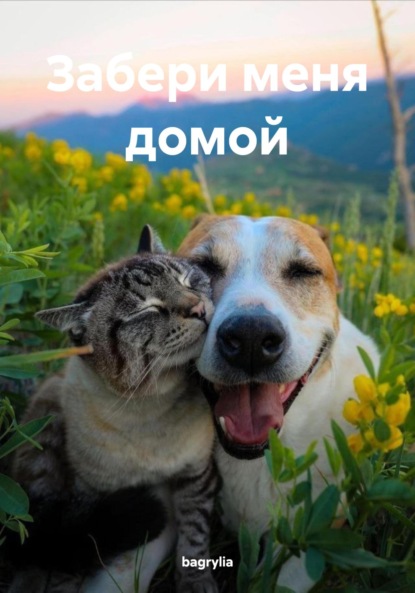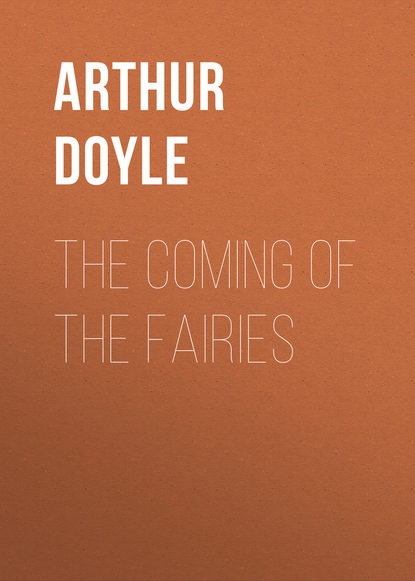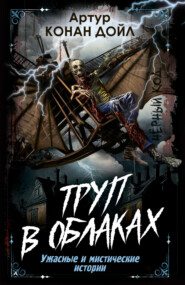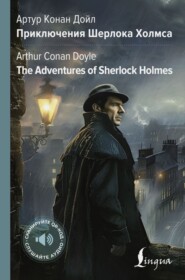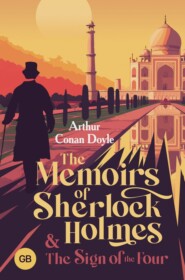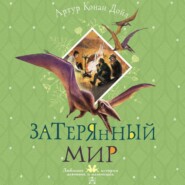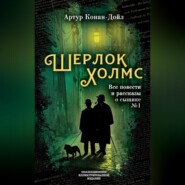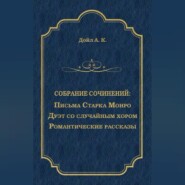По всем вопросам обращайтесь на: info@litportal.ru
(©) 2003-2024.
✖
The Coming of the Fairies
Настройки чтения
Размер шрифта
Высота строк
Поля
The Coming of the Fairies
Arthur Doyle
The Coming of the Fairies
PREFACE
This book contains reproductions of the famous Cottingley photographs, and gives the whole of the evidence in connection with them. The diligent reader is in almost as good a position as I am to form a judgment upon the authenticity of the pictures. This narrative is not a special plea for that authenticity, but is simply a collection of facts the inferences from which may be accepted or rejected as the reader may think fit.
I would warn the critic, however, not to be led away by the sophistry that because some professional trickster, apt at the game of deception, can produce a somewhat similar effect, therefore the originals were produced in the same way. There are few realities which cannot be imitated, and the ancient argument that because conjurers on their own prepared plates or stages can produce certain results, therefore similar results obtained by untrained people under natural conditions are also false, is surely discounted by the intelligent public.
I would add that this whole subject of the objective existence of a subhuman form of life has nothing to do with the larger and far more vital question of spiritualism. I should be sorry if my arguments in favour of the latter should be in any way weakened by my exposition of this very strange episode, which has really no bearing upon the continued existence of the individual.
Arthur Conan Doyle.
Crowborough,
March 1922.
CHAPTER I
HOW THE MATTER AROSE
The series of incidents set forth in this little volume represent either the most elaborate and ingenious hoax ever played upon the public, or else they constitute an event in human history which may in the future appear to have been epoch-making in its character. It is hard for the mind to grasp what the ultimate results may be if we have actually proved the existence upon the surface of this planet of a population which may be as numerous as the human race, which pursues its own strange life in its own strange way, and which is only separated from ourselves by some difference of vibrations. We see objects within the limits which make up our colour spectrum, with infinite vibrations, unused by us, on either side of them. If we could conceive a race of beings which were constructed in material which threw out shorter or longer vibrations, they would be invisible unless we could tune ourselves up or tone them down. It is exactly that power of tuning up and adapting itself to other vibrations which constitutes a clairvoyant, and there is nothing scientifically impossible, so far as I can see, in some people seeing that which is invisible to others. If the objects are indeed there, and if the inventive power of the human brain is turned upon the problem, it is likely that some sort of psychic spectacles, inconceivable to us at the moment, will be invented, and that we shall all be able to adapt ourselves to the new conditions. If high-tension electricity can be converted by a mechanical contrivance into a lower tension, keyed to other uses, then it is hard to see why something analogous might not occur with the vibrations of ether and the waves of light.
This, however, is mere speculation and leads me to the fact that early in May 1920 I heard, in conversation with my friend Mr. Gow, the Editor of Light, that alleged photographs of fairies had been taken. He had not actually seen them, but he referred me to Miss Scatcherd, a lady for whose knowledge and judgment I had considerable respect. I got into touch with her and found that she also had not seen the photographs, but she had a friend, Miss Gardner, who had actually done so. On May 13 Miss Scatcherd wrote to me saying that she was getting on the trail, and including an extract from a letter of Miss Gardner, which ran as follows. I am quoting actual documents in this early stage, for I think there are many who would like a complete inside view of all that led up to so remarkable an episode. Alluding to her brother Mr. Gardner, she says:
"You know that Edward is a Theosophist, has been for years, and now he is mostly engaged with lecturing and other work for the Society – and although for years I have regarded him as bathed in error and almost past praying for, I now find a talk with him an inspiring privilege. I am so very thankful that I happened to be in Willesden when his bereavement took place, for it was so wonderful to watch him, and to see how marvellously his faith and beliefs upheld and comforted him. He will probably devote more and more of his time and strength to going about the country lecturing, etc.
"I wish you could see a photo he has. He believes in fairies, pixies, goblins, etc. – children, in many cases, really see them and play with them. He has got into touch with a family in Bradford where the little girl, Elsie, and her cousin, Frances, constantly go into woods and play with the fairies. The father and mother are sceptical and have no sympathy with their nonsense, as they call it, but an aunt, whom Edward has interviewed, is quite sympathetic with the girls. Some little time ago, Elsie said she wanted to photograph them, and begged her father to lend his camera. For long he refused, but at last she managed to get the loan of it and one plate. Off she and Frances went into the woods near a waterfall. Frances ''ticed' them, as they call it, and Elsie stood ready with the camera. Soon the three fairies appeared, and one pixie dancing in Frances' aura. Elsie snapped and hoped for the best. It was a long time before the father would develop the photo, but at last he did, and to his utter amazement the four sweet little figures came out beautifully!
"Edward got the negative and took it to a specialist in photography who would know a fake at once. Sceptical as he was before he tested it, afterwards he offered £100 down for it. He pronounced it absolutely genuine and a perfectly remarkable photograph. Edward has it enlarged and hanging in his hall. He is very interested in it and as soon as possible he is going to Bradford to see the children. What do you think of this? Edward says the fairies are on the same line of evolution as the winged insects, etc., etc. I fear I cannot follow all his reasonings, but I knew you would be keenly interested. I wish you could see that photo and another one of the girls playing with the quaintest goblin imaginable!"
This letter filled me with hopes, and I renewed my pursuit of the photographs. I learned that they were two in number and that they had been sent for inspection to Miss Blomfield, a friend of the family. My chase turned, therefore, in that direction, and in reply to a letter of inquiry I received the following answer:
The Myrtles, Beckenham, June 21, 1920.
Dear Sir,
I am sending the two fairy pictures; they are interesting, are they not?
I am sure my cousin would be pleased for you to see them. But he said (and wrote it to me afterwards) that he did not want them to be used in any way at present. I believe he has plans in regard to them, and the pictures are being copyrighted. I don't think the copyright will be his. He has not yet finished his investigations. I asked him if I might photograph them myself so as to have a few prints to give to friends interested, but he wrote that he would rather nothing was done at present.
I think my cousin is away from home just now. But his name is Edward L. Gardner, and he is President of one of the branches of the Theosophical Society (Blavatsky Lodge), and he lectures fairly often at their Hall (Mortimer Hall, Mortimer Square, W.). He lectured there a few weeks ago, and showed the fairies on the screen and told what he knew about them.
Yours sincerely,
E. Blomfield.
This letter enclosed the two very remarkable photographs which are reproduced in this volume, that which depicted the dancing goblin, and the other of wood elves in a ring. An explanatory note setting forth the main points of each is appended to the reproductions. I was naturally delighted at the wonderful pictures, and wrote back thanking Miss Blomfield for her courtesy, and suggesting that an inquiry should be set on foot which would satisfy me as to the genuine nature of the photographs. If this were clearly established I hoped that I might be privileged to help Mr. Gardner in giving publicity to the discovery. In reply I had the following letter:
The Myrtles, Beckenham, June 23, 1920.
Dear Sir Arthur,
I am so glad you like the fairies! I should be only too glad to help in any way if I could, but there is so little I can do. Had the photographs been mine (I mean the negatives), I should have been most pleased that anything so lovely in the way of information should have been introduced to the public under such auspices. But it would, as things are, be necessary to ask my cousin. I believe he wants people to know, but, as I wrote before, I do not know his plans, and I'm not sure if he is ready.
It has occurred to me since writing to you that it would have been better had I given you his sister's address. She is a most sensible and practical person, much engaged in social work, with which her sympathetic nature and general efficiency make her very successful.
She believes the fairy photographs to be quite genuine. Edward is a clever man – and a good one. His evidence on any of the affairs of life would, I am sure, be considered most reliable by all who knew him, both for veracity and sound judgment. I hope these details will not bore you, but I thought perhaps some knowledge of the people who, so to say, "discovered" the photographs would help in taking you one step nearer the source. I do not see any opening for fraud or hoax, though at first when I saw the prints I thought there must be some other explanation than the simple one that they were what they seemed. They appeared too good to be true! But every little detail I have since heard has added to my conviction that they are genuine; though I have only what Edward tells me to go upon. He is hoping to obtain more from the same girls.
Yours sincerely,
E. Blomfield.
At about the same time I received a letter from another lady who had some knowledge of the matter. It ran thus:
29 Croftdown Road, Highgate Road, N.W., June 24, 1920.
Dear Sir Arthur,
I am glad to hear that you are interested in the fairies. If they were really taken, as there seems good reason to believe, the event is no less than the discovery of a new world. It may not be out of place to mention that when I examined them with a magnifying glass I noticed, as an artist, that the hands do not appear to be quite the same as ours. Though the little figures look otherwise so human, the hands seemed to me something like this. (There followed a sketch of a sort of fin.) The beard in the little gnome seems to me to be some sort of insect-like appendage, though it would, no doubt, be called a beard by a clairvoyant seeing him. Also it occurs to me that the whiteness of the fairies may be due to their lack of shadow, which may also explain their somewhat artificial-looking flatness.
Yours sincerely,
May Bowley.
I was now in a stronger position, since I had actually seen the photographs and learned that Mr. Gardner was a solid person with a reputation for sanity and character. I therefore wrote to him stating the links by which I had reached him, and saying how interested I was in the whole matter, and how essential it seemed that the facts should be given to the public, so that free investigation might be possible before it was too late. To this letter I had the following reply:
5 Craven Road, Harlesden, N.W.10., June 25, 1920.
Dear Sir,
Your interesting letter of the 22nd has just reached me, and very willingly I will assist you in any way that may be possible.
With regard to the photographs, the story is rather a long one and I have only gathered it by going very carefully. The children who were concerned are very shy and reserved indeed… They are of a mechanic's family of Yorkshire, and the children are said to have played with fairies and elves in the woods near their village since babyhood. I will not attempt to narrate the story here, however – perhaps we may meet for that – but when I at length obtained a view of the rather poor prints it so impressed me I begged for the actual negatives. These I submitted to two first-class photographic experts, one in London and one in Leeds. The first, who was unfamiliar with such matters, declared the plates to be perfectly genuine and unfaked, but inexplicable! The second, who did know something of the subject and had been instrumental in exposing several "psychic" fakes, was also entirely satisfied. Hence I proceeded.
I am hopeful of getting more photographs, but the immediate difficulty is to arrange for the two girls to be together. They are 16 or 17 years old and beginning to work and are separated by a few miles. It may be we can manage it and thus secure photographs of the other varieties besides those obtained. These nature spirits are of the non-individualized order and I should greatly like to secure some of the higher. But two children such as these are, are rare, and I fear now that we are late because almost certainly the inevitable will shortly happen, one of them will "fall in love" and then – hey presto!!
By the way, I am anxious to avoid the money consideration. I may not succeed, but would far rather not introduce it. We are out for Truth, and nothing soils the way so quickly. So far as I am concerned you shall have everything I can properly give you.
Sincerely yours,
(Sgd.) Edw. L. Gardner.
This letter led to my going to London and seeing Mr. Gardner, whom I found to be quiet, well-balanced, and reserved – not in the least of a wild or visionary type. He showed me beautiful enlargements of these two wonderful pictures, and he gave me much information which is embodied in my subsequent account. Neither he nor I had actually seen the girls, and it was arranged that he should handle the personal side of the matter, while I should examine the results and throw them into literary shape. It was arranged between us that he should visit the village as soon as convenient, and make the acquaintance of everyone concerned. In the meantime, I showed the positives, and sometimes the negatives, to several friends whose opinion upon psychic matters I respected.
Of these Sir Oliver Lodge holds a premier place. I can still see his astonished and interested face as he gazed at the pictures, which I placed before him in the hall of the Athenæum Club. With his usual caution he refused to accept them at their face value, and suggested the theory that the Californian Classical dancers had been taken and their picture superimposed upon a rural British background. I argued that we had certainly traced the pictures to two children of the artisan class, and that such photographic tricks would be entirely beyond them, but I failed to convince him, nor am I sure that even now he is whole-hearted in the matter.
My most earnest critics came from among the spiritualists, to whom a new order of being as remote from spirits as they are from human beings was an unfamiliar idea, and who feared, not unnaturally, that their intrusion would complicate that spiritual controversy which is vital to so many of us. One of these was a gentleman whom I will call Mr. Lancaster, who, by a not unusual paradox, combined considerable psychic powers, including both clairvoyance and clairaudience, with great proficiency in the practice of his very prosaic profession. He had claimed that he had frequently seen these little people with his own eyes, and I, therefore, attached importance to his opinion. This gentleman had a spirit guide (I have no objection to the smile of the sceptic), and to him he referred the question. The answer showed both the strength and the weakness of such psychic inquiries. Writing to me in July 1920, he said:
"Re Photographs: The more I think of it the less I like it (I mean the one with the Parisian-coiffed fairies). My own guide says it was taken by a fair man, short, with his hair brushed back; he has a studio with a lot of cameras, some of which are 'turned by a handle.' He did not make it to sell Spiritualists a 'pup,' but did it to please the little girl in the picture who wrote fairy stories which he illustrated in this fashion. He is not a Spiritualist, but would laugh very much if anyone was taken in by it. He does not live near where we were, and the place is all different, i.e. the houses, instead of being in straight lines, are dropped about all over the place. Apparently he was not English. I should think it was either Denmark or Los Angeles by the description, which I give you for what it is worth.
"I should very much like the lens which would take persons in rapid motion with the clarity of the photo in question, it must work at F 4.5 and cost fifty guineas if a penny, and not the sort of lens one would imagine the children in an artisan's household would possess in a hand camera. And yet with the speed with which it was taken the waterfall in the background is blurred sufficiently to justify a one second's exposure at least. What a doubting Thomas! I was told the other day that, in the unlikely event of my ever reaching heaven, I should (a) Insist on starting a card file index of the angels, and (b) Starting a rifle range to guard against the possibility of invasion from Hell. This being my unfortunate reputation at the hands of the people who claim to know me must discount my criticisms as carping – to a certain extent, at all events."
Arthur Doyle
The Coming of the Fairies
PREFACE
This book contains reproductions of the famous Cottingley photographs, and gives the whole of the evidence in connection with them. The diligent reader is in almost as good a position as I am to form a judgment upon the authenticity of the pictures. This narrative is not a special plea for that authenticity, but is simply a collection of facts the inferences from which may be accepted or rejected as the reader may think fit.
I would warn the critic, however, not to be led away by the sophistry that because some professional trickster, apt at the game of deception, can produce a somewhat similar effect, therefore the originals were produced in the same way. There are few realities which cannot be imitated, and the ancient argument that because conjurers on their own prepared plates or stages can produce certain results, therefore similar results obtained by untrained people under natural conditions are also false, is surely discounted by the intelligent public.
I would add that this whole subject of the objective existence of a subhuman form of life has nothing to do with the larger and far more vital question of spiritualism. I should be sorry if my arguments in favour of the latter should be in any way weakened by my exposition of this very strange episode, which has really no bearing upon the continued existence of the individual.
Arthur Conan Doyle.
Crowborough,
March 1922.
CHAPTER I
HOW THE MATTER AROSE
The series of incidents set forth in this little volume represent either the most elaborate and ingenious hoax ever played upon the public, or else they constitute an event in human history which may in the future appear to have been epoch-making in its character. It is hard for the mind to grasp what the ultimate results may be if we have actually proved the existence upon the surface of this planet of a population which may be as numerous as the human race, which pursues its own strange life in its own strange way, and which is only separated from ourselves by some difference of vibrations. We see objects within the limits which make up our colour spectrum, with infinite vibrations, unused by us, on either side of them. If we could conceive a race of beings which were constructed in material which threw out shorter or longer vibrations, they would be invisible unless we could tune ourselves up or tone them down. It is exactly that power of tuning up and adapting itself to other vibrations which constitutes a clairvoyant, and there is nothing scientifically impossible, so far as I can see, in some people seeing that which is invisible to others. If the objects are indeed there, and if the inventive power of the human brain is turned upon the problem, it is likely that some sort of psychic spectacles, inconceivable to us at the moment, will be invented, and that we shall all be able to adapt ourselves to the new conditions. If high-tension electricity can be converted by a mechanical contrivance into a lower tension, keyed to other uses, then it is hard to see why something analogous might not occur with the vibrations of ether and the waves of light.
This, however, is mere speculation and leads me to the fact that early in May 1920 I heard, in conversation with my friend Mr. Gow, the Editor of Light, that alleged photographs of fairies had been taken. He had not actually seen them, but he referred me to Miss Scatcherd, a lady for whose knowledge and judgment I had considerable respect. I got into touch with her and found that she also had not seen the photographs, but she had a friend, Miss Gardner, who had actually done so. On May 13 Miss Scatcherd wrote to me saying that she was getting on the trail, and including an extract from a letter of Miss Gardner, which ran as follows. I am quoting actual documents in this early stage, for I think there are many who would like a complete inside view of all that led up to so remarkable an episode. Alluding to her brother Mr. Gardner, she says:
"You know that Edward is a Theosophist, has been for years, and now he is mostly engaged with lecturing and other work for the Society – and although for years I have regarded him as bathed in error and almost past praying for, I now find a talk with him an inspiring privilege. I am so very thankful that I happened to be in Willesden when his bereavement took place, for it was so wonderful to watch him, and to see how marvellously his faith and beliefs upheld and comforted him. He will probably devote more and more of his time and strength to going about the country lecturing, etc.
"I wish you could see a photo he has. He believes in fairies, pixies, goblins, etc. – children, in many cases, really see them and play with them. He has got into touch with a family in Bradford where the little girl, Elsie, and her cousin, Frances, constantly go into woods and play with the fairies. The father and mother are sceptical and have no sympathy with their nonsense, as they call it, but an aunt, whom Edward has interviewed, is quite sympathetic with the girls. Some little time ago, Elsie said she wanted to photograph them, and begged her father to lend his camera. For long he refused, but at last she managed to get the loan of it and one plate. Off she and Frances went into the woods near a waterfall. Frances ''ticed' them, as they call it, and Elsie stood ready with the camera. Soon the three fairies appeared, and one pixie dancing in Frances' aura. Elsie snapped and hoped for the best. It was a long time before the father would develop the photo, but at last he did, and to his utter amazement the four sweet little figures came out beautifully!
"Edward got the negative and took it to a specialist in photography who would know a fake at once. Sceptical as he was before he tested it, afterwards he offered £100 down for it. He pronounced it absolutely genuine and a perfectly remarkable photograph. Edward has it enlarged and hanging in his hall. He is very interested in it and as soon as possible he is going to Bradford to see the children. What do you think of this? Edward says the fairies are on the same line of evolution as the winged insects, etc., etc. I fear I cannot follow all his reasonings, but I knew you would be keenly interested. I wish you could see that photo and another one of the girls playing with the quaintest goblin imaginable!"
This letter filled me with hopes, and I renewed my pursuit of the photographs. I learned that they were two in number and that they had been sent for inspection to Miss Blomfield, a friend of the family. My chase turned, therefore, in that direction, and in reply to a letter of inquiry I received the following answer:
The Myrtles, Beckenham, June 21, 1920.
Dear Sir,
I am sending the two fairy pictures; they are interesting, are they not?
I am sure my cousin would be pleased for you to see them. But he said (and wrote it to me afterwards) that he did not want them to be used in any way at present. I believe he has plans in regard to them, and the pictures are being copyrighted. I don't think the copyright will be his. He has not yet finished his investigations. I asked him if I might photograph them myself so as to have a few prints to give to friends interested, but he wrote that he would rather nothing was done at present.
I think my cousin is away from home just now. But his name is Edward L. Gardner, and he is President of one of the branches of the Theosophical Society (Blavatsky Lodge), and he lectures fairly often at their Hall (Mortimer Hall, Mortimer Square, W.). He lectured there a few weeks ago, and showed the fairies on the screen and told what he knew about them.
Yours sincerely,
E. Blomfield.
This letter enclosed the two very remarkable photographs which are reproduced in this volume, that which depicted the dancing goblin, and the other of wood elves in a ring. An explanatory note setting forth the main points of each is appended to the reproductions. I was naturally delighted at the wonderful pictures, and wrote back thanking Miss Blomfield for her courtesy, and suggesting that an inquiry should be set on foot which would satisfy me as to the genuine nature of the photographs. If this were clearly established I hoped that I might be privileged to help Mr. Gardner in giving publicity to the discovery. In reply I had the following letter:
The Myrtles, Beckenham, June 23, 1920.
Dear Sir Arthur,
I am so glad you like the fairies! I should be only too glad to help in any way if I could, but there is so little I can do. Had the photographs been mine (I mean the negatives), I should have been most pleased that anything so lovely in the way of information should have been introduced to the public under such auspices. But it would, as things are, be necessary to ask my cousin. I believe he wants people to know, but, as I wrote before, I do not know his plans, and I'm not sure if he is ready.
It has occurred to me since writing to you that it would have been better had I given you his sister's address. She is a most sensible and practical person, much engaged in social work, with which her sympathetic nature and general efficiency make her very successful.
She believes the fairy photographs to be quite genuine. Edward is a clever man – and a good one. His evidence on any of the affairs of life would, I am sure, be considered most reliable by all who knew him, both for veracity and sound judgment. I hope these details will not bore you, but I thought perhaps some knowledge of the people who, so to say, "discovered" the photographs would help in taking you one step nearer the source. I do not see any opening for fraud or hoax, though at first when I saw the prints I thought there must be some other explanation than the simple one that they were what they seemed. They appeared too good to be true! But every little detail I have since heard has added to my conviction that they are genuine; though I have only what Edward tells me to go upon. He is hoping to obtain more from the same girls.
Yours sincerely,
E. Blomfield.
At about the same time I received a letter from another lady who had some knowledge of the matter. It ran thus:
29 Croftdown Road, Highgate Road, N.W., June 24, 1920.
Dear Sir Arthur,
I am glad to hear that you are interested in the fairies. If they were really taken, as there seems good reason to believe, the event is no less than the discovery of a new world. It may not be out of place to mention that when I examined them with a magnifying glass I noticed, as an artist, that the hands do not appear to be quite the same as ours. Though the little figures look otherwise so human, the hands seemed to me something like this. (There followed a sketch of a sort of fin.) The beard in the little gnome seems to me to be some sort of insect-like appendage, though it would, no doubt, be called a beard by a clairvoyant seeing him. Also it occurs to me that the whiteness of the fairies may be due to their lack of shadow, which may also explain their somewhat artificial-looking flatness.
Yours sincerely,
May Bowley.
I was now in a stronger position, since I had actually seen the photographs and learned that Mr. Gardner was a solid person with a reputation for sanity and character. I therefore wrote to him stating the links by which I had reached him, and saying how interested I was in the whole matter, and how essential it seemed that the facts should be given to the public, so that free investigation might be possible before it was too late. To this letter I had the following reply:
5 Craven Road, Harlesden, N.W.10., June 25, 1920.
Dear Sir,
Your interesting letter of the 22nd has just reached me, and very willingly I will assist you in any way that may be possible.
With regard to the photographs, the story is rather a long one and I have only gathered it by going very carefully. The children who were concerned are very shy and reserved indeed… They are of a mechanic's family of Yorkshire, and the children are said to have played with fairies and elves in the woods near their village since babyhood. I will not attempt to narrate the story here, however – perhaps we may meet for that – but when I at length obtained a view of the rather poor prints it so impressed me I begged for the actual negatives. These I submitted to two first-class photographic experts, one in London and one in Leeds. The first, who was unfamiliar with such matters, declared the plates to be perfectly genuine and unfaked, but inexplicable! The second, who did know something of the subject and had been instrumental in exposing several "psychic" fakes, was also entirely satisfied. Hence I proceeded.
I am hopeful of getting more photographs, but the immediate difficulty is to arrange for the two girls to be together. They are 16 or 17 years old and beginning to work and are separated by a few miles. It may be we can manage it and thus secure photographs of the other varieties besides those obtained. These nature spirits are of the non-individualized order and I should greatly like to secure some of the higher. But two children such as these are, are rare, and I fear now that we are late because almost certainly the inevitable will shortly happen, one of them will "fall in love" and then – hey presto!!
By the way, I am anxious to avoid the money consideration. I may not succeed, but would far rather not introduce it. We are out for Truth, and nothing soils the way so quickly. So far as I am concerned you shall have everything I can properly give you.
Sincerely yours,
(Sgd.) Edw. L. Gardner.
This letter led to my going to London and seeing Mr. Gardner, whom I found to be quiet, well-balanced, and reserved – not in the least of a wild or visionary type. He showed me beautiful enlargements of these two wonderful pictures, and he gave me much information which is embodied in my subsequent account. Neither he nor I had actually seen the girls, and it was arranged that he should handle the personal side of the matter, while I should examine the results and throw them into literary shape. It was arranged between us that he should visit the village as soon as convenient, and make the acquaintance of everyone concerned. In the meantime, I showed the positives, and sometimes the negatives, to several friends whose opinion upon psychic matters I respected.
Of these Sir Oliver Lodge holds a premier place. I can still see his astonished and interested face as he gazed at the pictures, which I placed before him in the hall of the Athenæum Club. With his usual caution he refused to accept them at their face value, and suggested the theory that the Californian Classical dancers had been taken and their picture superimposed upon a rural British background. I argued that we had certainly traced the pictures to two children of the artisan class, and that such photographic tricks would be entirely beyond them, but I failed to convince him, nor am I sure that even now he is whole-hearted in the matter.
My most earnest critics came from among the spiritualists, to whom a new order of being as remote from spirits as they are from human beings was an unfamiliar idea, and who feared, not unnaturally, that their intrusion would complicate that spiritual controversy which is vital to so many of us. One of these was a gentleman whom I will call Mr. Lancaster, who, by a not unusual paradox, combined considerable psychic powers, including both clairvoyance and clairaudience, with great proficiency in the practice of his very prosaic profession. He had claimed that he had frequently seen these little people with his own eyes, and I, therefore, attached importance to his opinion. This gentleman had a spirit guide (I have no objection to the smile of the sceptic), and to him he referred the question. The answer showed both the strength and the weakness of such psychic inquiries. Writing to me in July 1920, he said:
"Re Photographs: The more I think of it the less I like it (I mean the one with the Parisian-coiffed fairies). My own guide says it was taken by a fair man, short, with his hair brushed back; he has a studio with a lot of cameras, some of which are 'turned by a handle.' He did not make it to sell Spiritualists a 'pup,' but did it to please the little girl in the picture who wrote fairy stories which he illustrated in this fashion. He is not a Spiritualist, but would laugh very much if anyone was taken in by it. He does not live near where we were, and the place is all different, i.e. the houses, instead of being in straight lines, are dropped about all over the place. Apparently he was not English. I should think it was either Denmark or Los Angeles by the description, which I give you for what it is worth.
"I should very much like the lens which would take persons in rapid motion with the clarity of the photo in question, it must work at F 4.5 and cost fifty guineas if a penny, and not the sort of lens one would imagine the children in an artisan's household would possess in a hand camera. And yet with the speed with which it was taken the waterfall in the background is blurred sufficiently to justify a one second's exposure at least. What a doubting Thomas! I was told the other day that, in the unlikely event of my ever reaching heaven, I should (a) Insist on starting a card file index of the angels, and (b) Starting a rifle range to guard against the possibility of invasion from Hell. This being my unfortunate reputation at the hands of the people who claim to know me must discount my criticisms as carping – to a certain extent, at all events."

